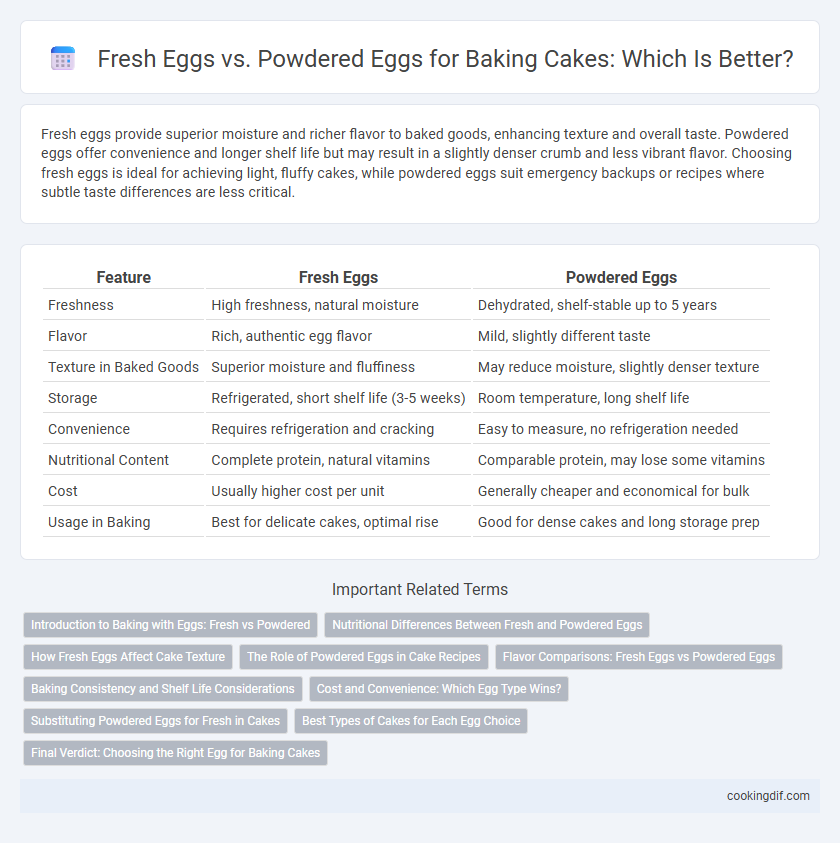Fresh eggs provide superior moisture and richer flavor to baked goods, enhancing texture and overall taste. Powdered eggs offer convenience and longer shelf life but may result in a slightly denser crumb and less vibrant flavor. Choosing fresh eggs is ideal for achieving light, fluffy cakes, while powdered eggs suit emergency backups or recipes where subtle taste differences are less critical.
Table of Comparison
| Feature | Fresh Eggs | Powdered Eggs |
|---|---|---|
| Freshness | High freshness, natural moisture | Dehydrated, shelf-stable up to 5 years |
| Flavor | Rich, authentic egg flavor | Mild, slightly different taste |
| Texture in Baked Goods | Superior moisture and fluffiness | May reduce moisture, slightly denser texture |
| Storage | Refrigerated, short shelf life (3-5 weeks) | Room temperature, long shelf life |
| Convenience | Requires refrigeration and cracking | Easy to measure, no refrigeration needed |
| Nutritional Content | Complete protein, natural vitamins | Comparable protein, may lose some vitamins |
| Cost | Usually higher cost per unit | Generally cheaper and economical for bulk |
| Usage in Baking | Best for delicate cakes, optimal rise | Good for dense cakes and long storage prep |
Introduction to Baking with Eggs: Fresh vs Powdered
Fresh eggs provide superior moisture, texture, and flavor in baking due to their natural protein structure and emulsifying properties. Powdered eggs offer convenience and longer shelf life, often used in large-scale or emergency baking but may alter the final cake's density and taste. Understanding the functional differences between fresh and powdered eggs helps bakers optimize recipes for desired cake quality and consistency.
Nutritional Differences Between Fresh and Powdered Eggs
Fresh eggs provide higher levels of naturally occurring vitamins such as vitamin D, B12, and choline, which are essential for brain function and bone health. Powdered eggs undergo dehydration processes that can lead to a reduction in certain heat-sensitive nutrients but offer a longer shelf life and convenience. Both forms contain similar amounts of protein and fat, making them viable for baking, though fresh eggs retain superior nutritional bioavailability.
How Fresh Eggs Affect Cake Texture
Fresh eggs contribute increased moisture and richness to cake batter, resulting in a tender and fluffy crumb. Their natural proteins and emulsifiers create better aeration, which enhances the cake's rise and overall texture. In contrast, powdered eggs may produce a denser cake due to their altered protein structure and reduced moisture content.
The Role of Powdered Eggs in Cake Recipes
Powdered eggs provide consistent moisture and binding properties essential for cake structure, making them a reliable alternative to fresh eggs in baking. Their extended shelf life and ease of storage help maintain recipe consistency, especially in large-scale or long-term baking projects. Although fresh eggs contribute to cake flavor and texture, powdered eggs enhance efficiency without significantly compromising the final product's quality.
Flavor Comparisons: Fresh Eggs vs Powdered Eggs
Fresh eggs provide a rich, natural flavor that enhances the overall taste and texture of baked goods, delivering a moist and tender crumb. Powdered eggs, while convenient and shelf-stable, often impart a slightly cooked or metallic aftertaste that can subtly alter the cake's flavor profile. Bakeries seeking optimal flavor quality typically prefer fresh eggs to maintain the authentic taste and delicate aroma of homemade cakes.
Baking Consistency and Shelf Life Considerations
Fresh eggs provide superior baking consistency due to their natural moisture and structure, which result in better texture and rise in cakes. Powdered eggs offer extended shelf life and convenient storage, making them ideal for long-term use without refrigeration. However, powdered eggs may slightly alter cake texture and flavor, requiring recipe adjustments to maintain desired baking results.
Cost and Convenience: Which Egg Type Wins?
Fresh eggs generally cost more per unit than powdered eggs but provide superior taste and texture in baking, making them ideal for quality-focused recipes. Powdered eggs offer unmatched convenience with longer shelf life, easy storage, and consistent availability, reducing waste and ensuring readiness for bulk or emergency baking needs. For cost-sensitive or large-scale baking, powdered eggs deliver economic advantages without compromising essential protein content, positioning them as a practical choice for cost and convenience-conscious bakers.
Substituting Powdered Eggs for Fresh in Cakes
Substituting powdered eggs for fresh eggs in cake recipes can impact texture and moisture levels due to differences in water content and protein structure. Powdered eggs offer convenience and longer shelf life but may require rehydration and careful measurement to match the binding and leavening properties of fresh eggs. Bakers often adjust liquid ratios and baking times to achieve similar rise and crumb consistency when using powdered eggs in cakes.
Best Types of Cakes for Each Egg Choice
Fresh eggs are ideal for delicate cakes like sponge, chiffon, and angel food cakes, where their natural moisture and structure enhance fluffiness and rise. Powdered eggs work well in dense cakes such as fruitcakes, gingerbread, and pound cakes, providing stable binding and long shelf life without compromising texture. Choosing the right egg form ensures optimal moisture retention, crumb texture, and overall cake quality.
Final Verdict: Choosing the Right Egg for Baking Cakes
Fresh eggs provide superior moisture and structure, resulting in a tender, rich crumb and enhanced flavor in cake baking. Powdered eggs offer convenience and longer shelf life but may yield slightly denser texture and less vibrant taste. For achieving optimal cake quality, fresh eggs are generally preferred, especially in recipes where texture and flavor are crucial.
Fresh Eggs vs Powdered Eggs for baking Infographic

 cookingdif.com
cookingdif.com